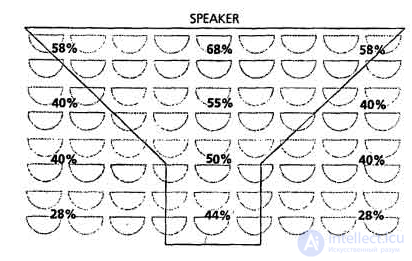Lecture
In the yearbook on human behavior, it is noted that people are most afraid to speak in public. For comparison, we say that the fear of death in this list comes in seventh place. Does this mean that during the funeral, anybody would prefer to carry the coffin rather than deliver the mourning speech?
If you have to speak to an audience, it is very important to imagine how the listeners perceive and assimilate information. First, never say at the beginning of your speech that you are worried and nervous, otherwise the audience will immediately start looking for appropriate signals of the language of gestures and will definitely find them. We assure you that if you don’t say it yourself, no one will guess that you are worried. Secondly, use gestures of confidence as often as possible, even if you die of fear. Put your palms in the "spire", use the open and closed positions of the palms, speak boldly and energetically. Do not point at the listeners, do not cross your arms over your chest, do not touch your face and do not cling to the edges of the chair. Studies show that people sitting in the front row, much better assimilate information. This is partly due to the fact that in the first row the most active and capable listeners usually sit, and in addition, they listen more attentively to the lecturer so that he does not find fault with them.
|
People sitting in the front row, better assimilate information, more actively and with great enthusiasm involved in the process. |
Students in the middle rows are also quite attentive and ask a lot of questions. Middle rows are considered the safest area of the hall, as they are surrounded by people from all sides. The most inattentive listeners sit on the side seats and the last rows. Do not forget to stand in the most favorable place of the scene - to the left of the audience, that is, on the right side of the scene. In this case, your information will have a stronger impact on the right hemisphere of the listeners' brain, which will cause an emotional response in most of them. Standing to the right of the listeners, that is, on the left side of the scene, you act on the left hemisphere of the listener's brain. That is why the audience laughs longer and with great pleasure when the speaker gets up on the left side of the stage. Remember that the left side of the stage is more suitable for a humorous performance, and the right side is more suitable for a serious and highly emotional one. Comedians are well aware: the audience laugh when you're on the left, and cry when you're on the right.
Attention area
Using the data obtained by Robert Sommer, Adams and Biddle, we conducted a study of the audience in order to assess the participation of delegates occupying certain places in the presentation process and the degree of assimilation of the information received. Our results almost completely coincided with those obtained by Robert Sommer, despite the fact that we examined adults and Sommer students. We also revealed certain cultural differences between Australians, Singaporeans, South Africans, Germans, British, French and Finns. People with high status are mainly located in the forefront (this is especially noticeable in Japan) and prefer not to be particularly active in the process. Therefore, we collected data only when all those present had the same status. We were able to identify the so-called "funnel effect".

Assessment of the assimilation of information and participation in the process depending on the place occupied by the listener
As you can see, the degree of attention of the audience in the audience varies. In any room there is a so-called “training zone” in the form of a funnel. It expands from the center of the audience and completely covers the front row. Listeners sitting inside this funnel are most attentive and active. They interact with the lecturer and best absorb the information received. Those who do not want to participate in the discussion prefer to sit in the last rows or on the side seats. These listeners are more negative and always ready for conflict. The degree of assimilation of information is the lowest. In the back rows, listeners have a great opportunity to take a nap, do their own business or just run away.
Comments
To leave a comment
Body language
Terms: Body language